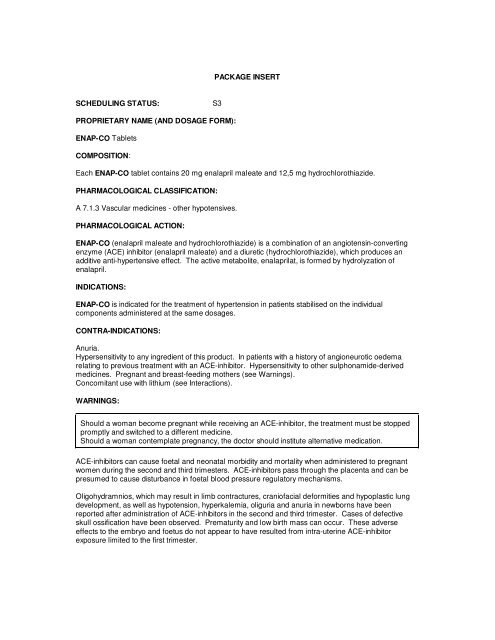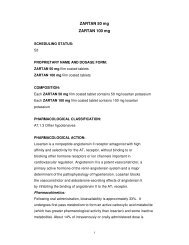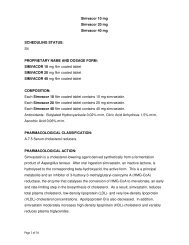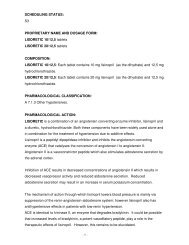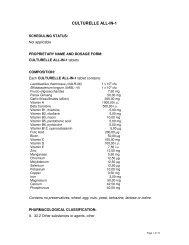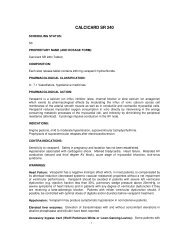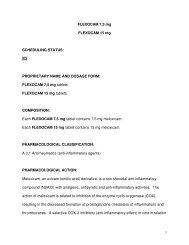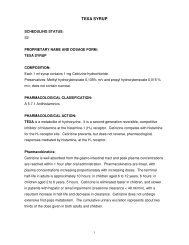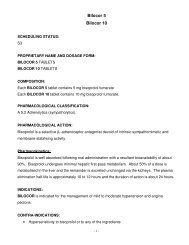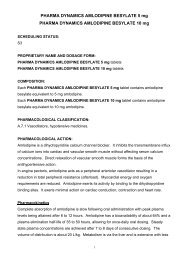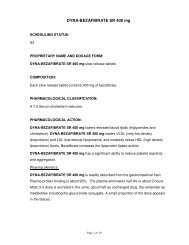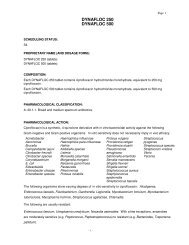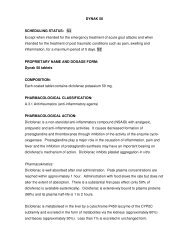ENAP-CO Tablets COMPOSITION - Pharma Dynamics
ENAP-CO Tablets COMPOSITION - Pharma Dynamics
ENAP-CO Tablets COMPOSITION - Pharma Dynamics
You also want an ePaper? Increase the reach of your titles
YUMPU automatically turns print PDFs into web optimized ePapers that Google loves.
SCHEDULING STATUS: S3<br />
PROPRIETARY NAME (AND DOSAGE FORM):<br />
<strong>ENAP</strong>-<strong>CO</strong> <strong>Tablets</strong><br />
<strong>CO</strong>MPOSITION:<br />
PACKAGE INSERT<br />
Each <strong>ENAP</strong>-<strong>CO</strong> tablet contains 20 mg enalapril maleate and 12,5 mg hydrochlorothiazide.<br />
PHARMA<strong>CO</strong>LOGICAL CLASSIFICATION:<br />
A 7.1.3 Vascular medicines - other hypotensives.<br />
PHARMA<strong>CO</strong>LOGICAL ACTION:<br />
<strong>ENAP</strong>-<strong>CO</strong> (enalapril maleate and hydrochlorothiazide) is a combination of an angiotensin-converting<br />
enzyme (ACE) inhibitor (enalapril maleate) and a diuretic (hydrochlorothiazide), which produces an<br />
additive anti-hypertensive effect. The active metabolite, enalaprilat, is formed by hydrolyzation of<br />
enalapril.<br />
INDICATIONS:<br />
<strong>ENAP</strong>-<strong>CO</strong> is indicated for the treatment of hypertension in patients stabilised on the individual<br />
components administered at the same dosages.<br />
<strong>CO</strong>NTRA-INDICATIONS:<br />
Anuria.<br />
Hypersensitivity to any ingredient of this product. In patients with a history of angioneurotic oedema<br />
relating to previous treatment with an ACE-inhibitor. Hypersensitivity to other sulphonamide-derived<br />
medicines. Pregnant and breast-feeding mothers (see Warnings).<br />
Concomitant use with lithium (see Interactions).<br />
WARNINGS:<br />
Should a woman become pregnant while receiving an ACE-inhibitor, the treatment must be stopped<br />
promptly and switched to a different medicine.<br />
Should a woman contemplate pregnancy, the doctor should institute alternative medication.<br />
ACE-inhibitors can cause foetal and neonatal morbidity and mortality when administered to pregnant<br />
women during the second and third trimesters. ACE-inhibitors pass through the placenta and can be<br />
presumed to cause disturbance in foetal blood pressure regulatory mechanisms.<br />
Oligohydramnios, which may result in limb contractures, craniofacial deformities and hypoplastic lung<br />
development, as well as hypotension, hyperkalemia, oliguria and anuria in newborns have been<br />
reported after administration of ACE-inhibitors in the second and third trimester. Cases of defective<br />
skull ossification have been observed. Prematurity and low birth mass can occur. These adverse<br />
effects to the embryo and foetus do not appear to have resulted from intra-uterine ACE-inhibitor<br />
exposure limited to the first trimester.
The routine use of diuretics in otherwise healthy pregnant women is not indicated and exposes mother<br />
and foetus to unnecessary hazard. Diuretics do not prevent development of toxaemia of pregnancy and<br />
there is no satisfactory evidence that they are useful in the treatment of toxaemia. Thiazides cross the<br />
placental barrier and appear in cord blood. Hazards include foetal and neonatal jaundice,<br />
thrombocytopenia and possibly other adverse reactions which occur in the adult.<br />
Infants whose mothers have taken <strong>ENAP</strong>-<strong>CO</strong> should be closely observed for hypotension, oliguria and<br />
hyperkalaemia. There is no experience with the removal of the combination product, <strong>ENAP</strong>-<strong>CO</strong>, from<br />
the neonatal circulation. Enalapril, which crosses the placenta, has been removed from the neonatal<br />
circulation by peritoneal dialysis with some clinical benefit. There is no experience with the removal of<br />
hydrochlorothiazide, which also crosses the placenta, from the neonatal circulation.<br />
Both enalapril and thiazides appear in human milk. If use of the medicine is deemed essential, the<br />
patient should stop nursing.<br />
After administration of the initial dose, symptomatic hypotension may occur. Hypotension is more likely<br />
in patients who have received prior diuretic therapy. Discontinue diuretic therapy for 2-3 days before<br />
therapy with <strong>ENAP</strong>-<strong>CO</strong> is initiated. In patients with ischaemic heart or cerebrovascular disease, therapy<br />
should be administered with extreme caution because an excessive fall in blood pressure could result in<br />
a myocardial infarction or cerebrovascular accident.<br />
Minor increases in blood urea and serum creatinine have developed in some hypertensive patients with<br />
no apparent pre-existing renal disease when enalapril has been given concomitantly with a diuretic.<br />
Should this occur during therapy with <strong>ENAP</strong>-<strong>CO</strong>, the combination should be discontinued.<br />
Minor alterations of fluid and electrolyte balance may precipitate hepatic encephalopathy and coma,<br />
therefore, <strong>ENAP</strong>-<strong>CO</strong> should be used with caution in patients with impaired hepatic function or<br />
progressive liver disease.<br />
DOSAGE AND DIRECTIONS FOR USE:<br />
Hypertension<br />
The usual dosage is one tablet, once a day. The dosage may be increased to a maximum of two<br />
tablets, administered once daily, if necessary.<br />
Dosage in Renal Insufficiency<br />
The use of thiazides may not be appropriate in patients with renal impairment. Thiazides are ineffective<br />
at creatinine clearance values of 30 ml/min or below (i.e. moderate or severe renal insufficiency).<br />
Do not use <strong>ENAP</strong>-<strong>CO</strong> as initial therapy in any patient with renal insufficiency.<br />
<strong>ENAP</strong>-<strong>CO</strong> may however be used in patients with creatinine clearance greater than 30 and less than 80<br />
ml/minute, but only after the individual components have been successfully titrated.<br />
SIDE-EFFECTS AND SPECIAL PRECAUTIONS:<br />
Side-effects:<br />
Dizziness and fatigue, the most common clinical side-effects, generally respond to dosage reduction.<br />
Other side-effects include: muscle cramps, nausea, aesthenia, orthostatic effects including<br />
hypotension, headaches, cough and impotence.<br />
Less common side-effects which have been reported include:<br />
Nervous System/Psychiatric<br />
Insomnia, somnolence, paraesthesia, vertigo, nervousness.<br />
Cardiovascular<br />
Syncope, non-orthostatic hypotension, palpitations, tachycardia, chest pain.
Respiratory<br />
Dyspnoea<br />
Gastro-intestinal<br />
Diarrhoea, vomiting, dyspepsia, abdominal pain, flatulence, constipation.<br />
Hypersensitivity/Angioneurotic Oedema<br />
Angioneurotic oedema of the face, extremities, lips, tongue, glottis and/or larynx has been reported (see<br />
Special Precautions).<br />
Other<br />
Renal dysfunction, renal failure, decreased libido, dry mouth, gout, tinnitus, arthralgia.<br />
A symptom complex which may include fever, serositis, vasculitis, myalgia, arthralgia/arthritis, a positive<br />
anti-nuclear antibody, elevated erythrocyte sedimentation rate, eosinophilia and leukocytosis, has been<br />
reported. Dermatologic manifestations, including skin rash and photosensitivity may occur.<br />
Skin<br />
Stevens-Johnson syndrome, rash, pruritus, diaphoresis.<br />
Laboratory Test Findings<br />
Cases of hyperglycaemia, hyperuricemia and hypokalemia have been recorded. In some patients,<br />
increases in blood urea and serum creatinine, and elevations of liver enzymes and/or serum bilirubin<br />
have occurred. These are usually reversible upon discontinuation of the combination medication.<br />
Hyperkalemia and hyponatremia have been noted. Decreases in haemoglobin, haematocrit, platelets<br />
and white cell count have been noted.<br />
Reports of neutropenia, thrombocytopenia and bone marrow depression have been received, but no<br />
direct casual relationship to the combination medication could be established.<br />
Side-effects reported for one of the individual components that may also contribute to side-effects<br />
encountered with this combination medication, include the following:<br />
Hydrochlorothiazide<br />
Anorexia, gastric irritation, jaundice (intrahepatic cholestatic jaundice), pancreatitis, sialoadenitis,<br />
xanthopsia, leukopenia, agranulocytosis, aplastic anaemia, haemolytic anaemia, purpura,<br />
photosensitivity, fever, urticaria, necrotizing angiitis (vasculitis), respiratory distress (including<br />
pneumonitis and pulmonary oedema), interstitial nephritis, anaphylactic reaction, glycosuria, electrolyte<br />
imbalance, including hyponatraemia, restlessness, muscle spasm, transient blurred vision.<br />
Enalapril<br />
Ileus, pancreatitis, hepatitis, either hepatocellular or cholestatic, jaundice, depression, confusion,<br />
bronchospasm/asthma, sore throat and hoarseness, cardiac rhythm disturbances, angina pectoris,<br />
myocardial infarction or cerebrovascular accident, possibly secondary to excessive hypotension in high<br />
risk patients, rhinorrhoea, photosensitivity, alopecia, flushing, taste alteration, anorexia, blurred vision,<br />
urticaria, stomatitis, glossitis, oliguria, toxic epidermal necrolysis, erythema multiforme, exfoliative<br />
dermatitis, pulmonary infiltrates, hepatic failure, pemphigus.<br />
Special Precautions:<br />
Anaphylactoid Reactions during Hymenoptera Desensitization<br />
Less frequently, patients receiving ACE inhibitors during desensitization with hymenoptera venom have<br />
experiences life-threatening anaphylactoid reactions. These reactions were avoided by temporarily<br />
withholding ACE-inhibitor therapy prior to each desensitization.<br />
Cough<br />
The use of ACE-inhibitors has been associated with cough. The cough is of a non-productive and<br />
persistent nature, which resolves after therapy is discontinued. ACE-inhibitor-induced cough should be<br />
considered as part of the differential diagnosis of cough.
Elderly Use<br />
No significant differences in efficacy and tolerability, were identified in elderly or younger hypertensive<br />
patients when enalapril maleate and hydrochlorothiazide were administered concominantly.<br />
Haemodialysis patients<br />
The use of this combination medication is not indicated in patients requiring dialysis for renal failure (see<br />
Dosage and Directions for Use). Anaphylactoid reactions have been reported in patients dialysed with<br />
high-flux membranes (e.g. AN69®), receiving concomitant ACE-inhibitor treatment. A different type of<br />
dialysis membrane or a different class of antihypertensive agent, should be considered when treating<br />
such patients.<br />
Hepatic Disease<br />
Thiazide should be used with caution in patients with impaired hepatic function or progressive liver<br />
disease, since minor alterations of fluid and electrolyte balance may precipitate hepatic coma.<br />
Hypersensitivity/Angioneurotic Oedema<br />
In some patients, angioneurotic oedema of the face, extremities, lips, tongue, glottis and/or larynx has<br />
been reported. Discontinue treatment in such cases and monitor patients to ensure complete<br />
resolution of symptoms. Where swelling is confined to the face and lips, the condition may resolve<br />
without treatment. Antihistamine treatment has proved useful in relieving these symptoms.<br />
Angioneurotic oedema associated with laryngeal oedema may be fatal. If involvement of the tongue,<br />
glottis or larynx, which is likely to cause airway obstruction should occur, appropriate therapy such as<br />
subcutaneous adrenaline solution 1:1 000 (0,3 ml to 0,5 ml) should be administered immediately.<br />
A history of angioedema unrelated to ACE-inhibitor therapy may expose patients to increased risk of<br />
developing angioedema while receiving an ACE-inhibitor. (See Contra-indications).<br />
Thiazide therapy may cause sensitivity reactions in certain patients, with or without, a history of allergy or<br />
bronchial asthma. Reports of exacerbation or activation of systemic lupus erythematosus have been<br />
associated with the use of thiazides.<br />
Hypotension and Electrolyte/Fluid imbalance<br />
Some patients may develop symptomatic hypotension. Such patients should be monitored for clinical<br />
signs of fluid or electrolyte imbalance, e.g. volume depletion, hyponatremia, hypochloremic alkalosis,<br />
hypomagnesaemia or hypokalemia which may occur during intercurrent diarrhoea or vomiting. Serum<br />
electrolytes should be periodically determined at appropriate intervals when treating these patients.<br />
If hypotension occurs, the patient should be made to lie down and, if necessary, an intravenous infusion<br />
of normal saline should be administered. A transient hypotensive response is not a contra-indication to<br />
further doses. Provided blood volume and pressure have been restored effectively, reintroduction of<br />
therapy using reduced doses can be considered; as an alternative, either of the components may be<br />
administered as monotherapy.<br />
Metabolic and Endocrine Effects<br />
Glucose tolerance may be impaired by thiazide therapy. Dosage of antidiabetic agents including<br />
insulin, may need to be adjusted. Thiazides may decrease urinary calcium excretion and cause<br />
intermittent and slight elevation of serum calcium. It should be kept in mind, that marked<br />
hypercalcinemia may be evidence of hidden hyperparathyroidism. Discontinue thiazides before<br />
carrying out tests of parathyroid function.<br />
In some cases, thiazide diuretic therapy may be associated with increases in cholesterol and triglyceride<br />
levels.<br />
In certain patients thiazide therapy may precipitate hyperuricemia and/or gout, enalapril may, however,<br />
increase urinary uric acid and thus attenuate the hyperuricemic effect of hydrochlorothiazide.<br />
Paediatric use<br />
The safety and efficacy of the combination medication in children have not been established.<br />
Renal Function Impairment
See Dosage in Renal Insufficiency under Dosage and Directions for Use.<br />
Increases in blood urea and serum creatinine have been seen in some patients with bilateral renal<br />
artery stenosis or stenosis of the artery to a solitary kidney, who were receiving treatment with ACEinhibitors;<br />
these symptoms are reversible upon discontinuation of therapy.<br />
Surgery/Anaesthesia<br />
Enalapril is known to block angiotensin II formation secondary to compensatory renin release in patients<br />
undergoing major surgery or during anaesthesia with agents that produce hypotension. Should<br />
hypotension occur and be considered to be due to this mechanism, volume expansion can be used to<br />
correct the fall in blood pressure.<br />
Interactions:<br />
Concurrent use of the following drugs may cause interactions with thiazide diuretics:<br />
Anti-diabetic medicine (oral agents and insulin) - the dosage of the anti-diabetic medication may have<br />
to be adjusted.<br />
Alcohol, Barbiturates or Narcotics - may potentiate orthostatic hypotension.<br />
Corticosteroids, ACTH - increased electrolyte depletion, particularly hypokalemia, may occur.<br />
Non-steroidal Anti-inflammatory Agents - reduction of the diuretic, natriuretic and anti-hypertensive<br />
effects of diuretics in certain patients.<br />
Pressor Amines (e.g. adrenalin) - a decreased response to pressor amines may occur, but this is<br />
generally not sufficient to preclude their use.<br />
Other interactions:<br />
Lithium<br />
The combination of lithium and diuretics should be avoided. Renal clearance of lithium is reduced by<br />
diuretic agents and ACE-inhibitors, exposing patients to a high risk of lithium toxicity. Refer to lithium<br />
preparation package inserts before use of such preparations.<br />
Non-depolarising Muscle Relaxants<br />
Responsiveness to tubocurarine may be increased during thiazide therapy.<br />
Other Antihypertensive Therapy<br />
The combination of enalapril with ganglionic blocking agents or adrenergic blocking agents, should only<br />
be considered if the patient can be kept under careful observation.<br />
Serum Potassium<br />
The effect of enalapril usually attenuates the depletion of potassium by thiazide diuretics.<br />
Serum potassium levels may be significantly increased, particularly in patients with impaired renal<br />
function if potassium supplements, potassium-sparing agents or potassium-containing salt substitutes,<br />
are used.<br />
KNOWN SYMPTOMS OF OVERDOSAGE AND PARTICULARS OF ITS TREATMENT:<br />
No specific information for the treatment of overdosage with the combination medication is available at<br />
present. Treatment is symptomatic and supportive. The following measures have been suggested:<br />
induction of emesis and/or gastric lavage, correction of dehydration, electrolyte imbalance and<br />
hypotension using established procedures which should be introduced within 2 hours after ingestion.<br />
Hydrochlorothiazide<br />
Overdosage with thiazides is commonly associated with signs and symptoms caused by electrolyte
depletion (hypokalemia, hypochloremia, hyponatremia) and dehydration resulting from excessive<br />
diuresis. Hypokalemia may accentuate cardiac arrhythmias if digitalis has also been administered.<br />
Enalapril Maleate<br />
Overdosage is primarily characterised by hypotension, which commences approximately six hours after<br />
ingestion of tablets, resulting from blockade of the renin-angiotensin system, and stupor.<br />
Haemodialysis can be used to remove enalaprilat from the general circulation.<br />
IDENTIFICATION:<br />
A round, white, flat, tablet with a bevelled edge, scored on one side.<br />
PRESENTATION:<br />
Available in blisters of 30 tablets.<br />
STORAGE INSTRUCTIONS:<br />
Store in a cool (below 25°C), dry place. Protect from light and moisture.<br />
KEEP OUT OF REACH OF CHILDREN.<br />
REGISTRATION NUMBER:<br />
34/7.1.3/0088<br />
NAME AND BUSINESS ADDRESS OF APPLICANT:<br />
<strong>Pharma</strong> <strong>Dynamics</strong> (Pty) Ltd<br />
F02 Grapevine House<br />
Steenberg Office Park<br />
Westlake<br />
7945<br />
DATE OF PUBLICATION OF THIS PACKAGE INSERT:<br />
7 February 2000
SKEDULERINGSTATUS: S3<br />
EIENDOMSNAAM (EN DOSEERVORM):<br />
<strong>ENAP</strong>-<strong>CO</strong> (tablet)<br />
SAMESTELLING:<br />
VOUBILJET<br />
Elke <strong>ENAP</strong>-<strong>CO</strong> tablet bevat 20 mg enalaprielmaleaat en 12,5 mg hidrochloortiasied.<br />
FARMAKOLOGIESE KLASSIFIKASIE:<br />
A 7.1.3 Vaskulêre medisyne - ander hipotensiewe middels.<br />
FARMAKOLOGIESE WERKING:<br />
<strong>ENAP</strong>-<strong>CO</strong> (enalaprielmaleaat en hidrochloortiasied) is ‘n kombinasie van ‘n<br />
angiotensienomsettingsensiem (AOE)-inhibeerder (enalaprielmaleaat) en ‘n diuretikum<br />
(hidrochloortiasied), wat ‘n additiewe antihipertensiewe uitwerking bewerkstellig. Die aktiewe<br />
metaboliet, enalaprilaat, word deur hidrolisering van enalapriel gevorm.<br />
INDIKASIES:<br />
<strong>ENAP</strong>-<strong>CO</strong> word aangedui vir die behandeling van hipertensie in pasiënte wat op die individuele<br />
komponente wat teen dieselfde doserings toegedien word, gestabiliseer is.<br />
KONTRA-INDIKASIES:<br />
Anurie.<br />
Hipersensitiwiteit teenoor enige komponent van hierdie produk. In pasiënte met ‘n geskiedenis van<br />
angioneurotiese edeem verwant aan vorige behandeling met ‘n AOE-inhibeerder. Hipersentiwiteit<br />
teenoor ander sulfonamied-afgeleide medisyne. Swanger en borsvoedende moeders (sien<br />
Waarskuwings). Gelyktydige gebruik van litium (sien Interaksies).<br />
WAARSKUWINGS:<br />
Indien ‘n vrou sou swanger raak terwyl sy ‘n AOE-remmer ontvang, moet die behandeling<br />
onmiddellik gestaak word en oorgeskakel word na alternatiewe medikasie.<br />
Indien ‘n vrou swangerskap oorweeg, moet die geneesheer alternatiewe medikasie instel.<br />
AOE-inhibeerders kan fetale en neonatale morbiditeit en mortaliteit veroorsaak wanneer dit toegedien<br />
word aan swanger vroue gedurende die tweede en derde trimesters. AOE-inhibeerders kruis die<br />
plasenta en kan vermoedelik versteuring van fetale bloeddrukreguleringsmeganismes veroorsaak.<br />
Oligohidramnios, wat kontrakture van ledemate, kraniofasiale wanvormings en hipoplastiese<br />
longontwikkeling tot gevolg mag hê, sowel as hipotensie, hiperkalemie, oligurie en anurie is in<br />
pasgeborenes na toediening van AOE-inhibeerders gedurende die tweede en derde trimester,<br />
aangemeld. Gevalle van gebrekkige skedel-ossifisering is waargeneem. Vroeggeboorte en lae<br />
geboortegewig kan voorkom. Intra-uteriene AOE-inhibeerder blootstelling wat die eerste trimester<br />
beperk was, het skynbaar nie hierdie nadelige uitwerkings op die embrio en fetus gehad nie.<br />
Die roetine gebruik van diuretika in andersins gesonde swanger vrouens is nie aangedui nie en dit stel<br />
die moeder en fetus aan onnodige gevaar bloot. Diuretika verhoed nie ontwikkeling van toksemie in<br />
swangerskap en daar bestaan geen bevredigende bewyse dat hierdie middels nuttig in die behandeling<br />
van toksemie kan wees nie. Tiasiede kruis die plasentale skans en verskyn in koordbloed. Gevare sluit<br />
fetale en neonatale geelsug, trombositopenie en moontlik ook ander nadelige reaksies wat in<br />
volwassenes voorkom, in.
Suigelinge van moeders wat <strong>ENAP</strong>-<strong>CO</strong> geneem het, behoort noukeurig vir hipotensie, oligurie en<br />
hiperkalemie, dopgehou te word. Daar is geen ondervinding met die verwydering van die kombinasie<br />
produk, <strong>ENAP</strong>-<strong>CO</strong>, uit die neonatale bloedsomloop beskikbaar nie. Enalapriel, wat die plasenta kruis,<br />
is met ‘n mate van kliniese voordeel uit die neonatale bloedsomloop verwyder met behulp van<br />
peritoneale dialise. Geen ondervinding met die verwydering van hidrochloortiasied wat ook die plasenta<br />
kruis, uit die neonatale bloedsomloop is beskikbaar nie.<br />
Beide enalapriel en tiasiede verskyn in menslike melk. Indien die gebruik van die medisyne as<br />
essensieel beskou word, moet die pasiënt borsvoeding staak.<br />
Na toediening van die eerste dosis, mag simptomatiese hipotensie voorkom. Hipotensie is meer geneig<br />
om voor te kom in pasiënte wat vroeër diuretika-terapie ontvang het. Staak diuretika-terapie vir 2-3 dae<br />
voor terapie met <strong>ENAP</strong>-<strong>CO</strong> begin word. In pasiënte met iskemiese hart- of serebrovaskulêre siekte,<br />
behoort terapie met groot versigtigheid toegedien te word omdat ‘n oormatige val in bloeddruk moontlik<br />
‘n miokardiale infarksie of serebrovaskulêre insident kan veroorsaak.<br />
Klein toenames in bloedureum en serumkreatinien het in sommige hipertensiewe pasiënte met geen<br />
duidelike vooraf-bestaande niersiekte voorgekom toe enalapriel saam met ‘n diuretikum toegedien is.<br />
As dit tydens terapie met <strong>ENAP</strong>-<strong>CO</strong> sou voorkom, behoort die kombinasie gestaak te word.<br />
Klein veranderings in vloeistof- en elektrolietbalans mag hepatiese ensefalopatie en koma presipiteer.<br />
Dus behoort <strong>ENAP</strong>-<strong>CO</strong> met omsig in pasiënte met ingekorte lewerfunksie of progressiewe lewersiekte<br />
gebruik te word.<br />
DOSIS EN GEBRUIKSAANWYSINGS:<br />
Hipertensie<br />
Die gewone dosering is een tablet een keer per dag. Die dosering mag, indien nodig, tot ‘n maksimum<br />
van twee tablette wat een keer per dag toegedien word, verhoog word.<br />
Dosering in Nierontoereikendheid<br />
In pasiënte met nierontoereikendheid mag die gebruik van tiasiede nie toepaslik wees nie. Tiasiede is<br />
nie effektief by kreatinienopruimingswaardes van 30 ml/min of laer (d.i. matige tot ernstige<br />
nierontoereikendheid).<br />
Moenie <strong>ENAP</strong>-<strong>CO</strong> as aanvangsterapie in enige pasiënt met nierontoereikendheid gebruik nie.<br />
<strong>ENAP</strong>-<strong>CO</strong> mag egter gebruik word in pasiënte met kreatinienopruiming wat hoër as 30, en laer as 80<br />
ml/min is, maar slegs nadat die individuele komponente suksesvol getitreer is.<br />
NEWE-EFFEKTE EN SPESIALE VOORSORGMAATREËLS:<br />
Newe-effekte:<br />
Duiseligheid en moegheid, die mees algemene kliniese newe-effekte, reageer gewoonlik tot<br />
dosisvermindering. Ander newe-effekte sluit in: spierkrampe, naarheid, asthenia, ortostatiese<br />
uitwerkings insluitend hipotensie, hoofpyne, hoes en impotensie.<br />
Minder algemene newe-effekte wat gerapporteer is, sluit in:<br />
Senuweestelsel/Psigiatries<br />
Slaaploosheid, slaperigheid, parestesie, vertigo, senuagtigheid.<br />
Kardiovaskulêr<br />
Sinkopee, nie-ortostatiese hipotensie, hartkloppings, tagikardie, borspyn.<br />
Respiratories<br />
Dispnee.<br />
Gastro-intestinaal<br />
Diarree, braking, dispepsie, abdominale pyn, winderigheid, hardlywigheid.
Hipersensitiwiteit/Angioneurotiese Edeem<br />
Angioneurotiese edeem van die gesig, ekstremiteite, lippe, tong, glottis en/of larinks is al gerapporteer<br />
(sien Spesiale Voorsorgmaatreëls).<br />
Ander<br />
Renale disfunksie, nierversaking, verminderde libido, droë mond, jig, tinnitus, artralgie.<br />
‘n Simptoomkompleks wat koors, serositis, vaskulitis, mialgie, artralgie/artritis, ‘n positiewe anti-nukleêre<br />
teenliggaampie, verhoogde eritrosiet-sedimentasietempo, eosinofilie, en leukositose mag insluit, is<br />
gerapporteer. Dermatologiese manifestasies, insluitend veluitslag of fotosensitiwiteit, mag ook<br />
voorkom.<br />
Vel<br />
Stevens-Johnson-sindroom, veluitslag, pruritus, diaforese.<br />
Laboratoriumtoetsbevindings<br />
Gevalle van hiperglisemie, hiperurisemie en hipokalemie is al aangeteken. In sommige pasiënte is<br />
verhogings in bloedureum en serumkreatinien, en verhoogde lewerensieme en/of<br />
serumbilirubienvlakke waargeneem. Hierdie bevindings is normaalweg omkeerbaar na staking van die<br />
gekombineerde terapie. Hiperkalemie en hiponatremie is waargeneem. Verminderings in<br />
hemoglobien, hematokrit, plaatjies en wit seltelling is gerapporteer.<br />
Berigte van neutropenie, trombositopenie en beenmurgonderdrukking is al ontvang, maar geen direkte<br />
oorsaaklike verwantskap met die kombinasie medikasie kon vasgestel word nie.<br />
Newe-effekte wat vir een van die individuele komponente geraporteer is, en ook mag bydra tot die<br />
newe-effekte wat met hierdie kombinasie ondervind word, sluit die volgende in:<br />
Hidrochloortiasied<br />
Anoreksie, gastriese irritasie, geelsug (intrahepatiese cholestatiese geelsug), pankreatitis, sialadenitis,<br />
xantopsie, leukopenie, agranulositose, aplastiese anemie, hemolitiese anemie, purpura,<br />
fotosensitiwiteit, koors, urtikarie, nekrotiserende angiïtis (vaskulitis), respiratoriese nood (insluitend<br />
longontsteking en pulmonale edeem), interstisiële nefritis, anafilaktiese reaksie, glikosurie,<br />
elektrolietwanbalans, insluitend hiponatremie, rusteloosheid, spierspasma, verbygaande versteurde<br />
visie.<br />
Enalapriel<br />
Ileus, pankreatitis, hepatitis, óf sellulêr óf cholestaties, geelsug, depressie, verwarring, brongospasma/<br />
asma, seer keel en heesheid, versteurings van hart-ritme, angina pectoris, miokardiale infarksie óf<br />
serebrovaskulêre insident, moontlik sekondêr tot oormatige hipotensie in hoë-risiko pasiënte, rinoree,<br />
fotosensitiwiteit, alopesie, blosing, smaakveranderings, anoreksie, versteurde visie, urtikarie, stomatitis,<br />
glossitis, oligurie, toksiese epidermale nekrolise, erythema multiforme, eksfoliatiewe dermatitis,<br />
pulmonale infiltrate, hepatiese versaking, pemfigus.<br />
Spesiale Voorsorgmaatreëls<br />
Anafilaktoïed Reaksies tydens Hymenoptera Desensitisering<br />
Minder dikwels het pasiënte wat AOE-inhibeerders tydens desensitisering met hymenoptera gif ontvang<br />
het, lewensbedreigende anafilaktoïede reaksies ondervind. Hierdie reaksies is vermy deur AOEinhibeerderterapie<br />
tydelik voor elke desensitisering te weerhou.<br />
Hoes<br />
Die gebruik van AOE-inhibeerders is al met hoes geassosieer. Die hoes is kenmerkend nie-produktief<br />
en aanhoudend van aard, en dit verdwyn na staking van terapie. AOE-inhibeerder-geïnduseerde hoes<br />
moet as deel van die differensiële diagnose van hoes, beskou word.<br />
Gebruik in bejaardes<br />
Geen beduidende verskille in doeltreffendheid en verdraagbaarheid is in bejaarde of jonger<br />
hipertensiewe pasiënte uitgeken nie, toe enalaprielmaleaat en hidrochloortiasied gelyktydig toegedien<br />
is.
Hemodialise Pasiënte<br />
Die gebruik van hierdie kombinasie medikasie is nie aangedui in pasiënte wat dialise vir nierversaking<br />
benodig nie (sien Dosis en Gebruiksaanwysings). Anafilaktoïede reaksies is in pasiënte gerapporteer<br />
tydens dialise met hoë-vloei membrane (byvoorbeeld AN 69®) wat gelyktydig ‘n AOE-inhibeerder<br />
ontvang het. ‘n Ander soort dialise membraan of ‘n ander klas antihipertensiewe middel moet oorweeg<br />
word wanneer hierdie pasiënte behandel word.<br />
Hepatiese Siekte<br />
Tiasiede moet met omsig gebruik word in pasiënte met ingekorte lewerfunksie of progressiewe<br />
lewersiekte, omdat klein veranderings in vloeistof- en elektrolietbalans, hepatiese koma mag<br />
presipiteer.<br />
Hipersensitiwiteit/Angioneurotiese Edeem<br />
In sommige pasiënte is angioneurotiese edeem van die gesig, ekstremiteite, lippe, tong, glottis en/of<br />
larinks gerapporteer. Staak behandeling in sulke gevalle en moniteer pasiënte om volkome verligting<br />
van simptome te verseker. In gevalle waar die swelling tot die gesig en lippe beperk is, mag die<br />
toestand sonder behandeling herstel. Antihistamienbehandeling was nuttig om hierdie simptome te<br />
verlig. Angioneurotiese edeem wat met laringeale edeem geassosieer is, mag fataal wees. Indien<br />
betrokkenheid van die tong, glottis of larinks, wat moontlik lugwegobstruksie kan veroorsaak, sou<br />
voorkom, behoort gepaste terapie soos subkutane adrenalienoplossing 1:1 000 (0,3 ml tot 0,5 ml)<br />
onmiddellik toegedien te word.<br />
‘n Geskiedenis van angio-edeem, onverwant aan AOE-inhibeerderterapie, mag pasiënte aan ‘n groter<br />
risiko vir angio-edeem blootstel terwyl hulle ‘n AOE-inhibeerder ontvang (sien Kontra-indikasies).<br />
Tiasiedterapie mag sensitiwiteitsreaksies in sekere pasiënte, met óf sonder, ‘n geskiedenis van allergie<br />
of brongiale asma, veroorsaak. Berigte van verergerings of aktiverings van sistemiese lupus<br />
eritematose is al met die gebruik van tiasiede geassosieer.<br />
Hipotensie en Elektroliet-/Vloeistofwanbalans<br />
Sommige pasiënte mag simptomatiese hipotensie ontwikkel. Sulke pasiënte behoort vir kliniese tekens<br />
van vloeistof- of elektrolietwanbalans gemoniteer te word, b.v. volume-uitputting, hiponatremie,<br />
hipochloremiese alkalose, hipomagnesemie of hipokalemie wat tydens bykomende diarree of braking<br />
mag voorkom. Serumelektroliete behoort periodiek op geskikte tussenposes gemoniteer te word<br />
tydens behandeling van hierdie pasiënte.<br />
Indien hipotensie voorkom, behoort die pasiënt in ‘n rugliggende posisie geplaas te word, en indien<br />
nodig moet ‘n intraveneuse infusie van standaard soutoplossing toegedien word. ‘n Verbygaande<br />
hipotensie reaksie is nie ‘n teenaanduidings vir addisionele dosisse nie. Op voorwaarde dat<br />
bloedvolume en -druk effektief herstel is, kan her-instelling van terapie teen verminderde dosisse<br />
oorweeg word; as alternatief kan een van die twee komponente as monoterapie toegedien word.<br />
Metaboliese en Endokriene Uitwerkings<br />
Glukosetoleransie mag deur tiasiedterapie ingekort word. Dit mag nodig blyk te wees om dosering van<br />
antidiabetiese middels, insluitend insulien, aan te pas. Tiasiede mag urinêre kalsiumuitskeiding<br />
verminder en wisselvallige en klein verhogings van serumkalsium veroorsaak. Dit moet in gedagte<br />
gehou word dat uitgesproke hiperkalsemie ‘n teken van verborge hiperparatiroïedisme mag wees.<br />
Staak tiasiede alvorens toetse vir paratiroïedfunksie uitgevoer word.<br />
In sommige gevalle mag tiasied diuretika-terapie met verhogings in cholesterol- en trigliseriedvlakke<br />
geassosieer wees.<br />
In sekere pasiënte mag tiasiedterapie hiperurisemie en/of jig presipiteer, maar enalapriel mag egter<br />
urinêre uriensuur verhoog en dus die hiperurisemiese uitwerking van hidrochloortiasied verswak.<br />
Pediatriese gebruik<br />
Die veiligheid en doeltreffendheid van die kombinasie medikasie in kinders is nog nie vasgestel nie.<br />
Inkorting van Nierfunksie<br />
Sien Dosering in Nierontoereikendheid onder Dosis en Gebruiksaanwysings.
Toenames in bloedureum en serumkreatinien is waargeneem in sommige pasiënte met bilaterale<br />
renale arteriestenose of stenose van die arterie na ‘n enkele nier wat behandeling met AOEinhibeerders<br />
ontvang het; hierdie simptome is omkeerbaar na staking van terapie.<br />
Chirurgie/Narkose<br />
Dit is bekend dat enalapriel angiotensien-II-vorming sekondêr tot kompensatoriese renienvrystelling<br />
blokkeer in pasiënte wat majoor chirurgie ondergaan of gedurende narkose met middels wat hipotensie<br />
veroorsaak. Indien hipotensie sou voorkom en dit word vermoed dat dit die gevolg van hierdie<br />
meganisme is, kan volume-uitsetting gebruik word om die val in bloeddruk te korrigeer.<br />
Interaksies:<br />
Gelyktydige gebruik van die volgende geneesmiddels mag interaksies met tiasied-diuretika veroorsaak:<br />
Antidiabetiese medisyne (orale middels en insulien) - dit mag nodig wees om die dosering van die antidiabetiese<br />
medikasie aan te pas.<br />
Alkohol, Barbiturate en Narkotika - mag ortostatiese hipotensie versterk.<br />
Kortikosteroïede, AKTH - verhoogde elektroliet-uitputting, veral hipokalemie, mag voorkom.<br />
Nie-steroïedale Anti-inflammatoriese Middels - vermindering van die diuretiese, natriuretiese en antihipertensiewe<br />
uitwerkings van diuretika in sekere pasiënte.<br />
Pressoramiene (bv. Adrenalien) - ‘n verminderde reaksie teenoor pressoramiene mag voorkom, maar<br />
dit is gewoonlik nie van so ‘n aard dat dit hulle gebruik uitskakel nie.<br />
Ander Interaksies:<br />
Litium<br />
Die kombinasie van litium en diuretika behoort vermy te word. Nieropruiming van litium word deur<br />
diuretika en AOE-inhibeerders verminder, wat pasiënte aan ‘n hoë risiko vir litiumtoksisiteit blootstel.<br />
Verwys na die voubiljette van litium-preparate alvorens sulke middels gebruik word.<br />
Nie-depolariserende Spierverslappers<br />
Reaksie tot tubokurarien mag tydens tiasiedterapie verhoog word.<br />
Ander Antihipertensiewe terapie<br />
Die kombinasie van enalapriel met ganglioniese blokkeerders of adrenergiese blokkeerders moet<br />
alleen oorweeg word indien die pasiënte onder sorgvuldige toesig gehou kan word.<br />
Serumkalium<br />
Die uitwerking van enalapriel verswak gewoonlik die uitputting van kalium deur tiasied-diuretika.<br />
Serumkaliumvlakke mag beduidend verhoog wees, veral in pasiënte met ingekorte nierfunksie indien<br />
kaliumsupplemente, kaliumsparende middels, of kalium-bevattende soutvervangers, gebruik word.<br />
Die toediening van enalapriel aan pasiënte met nierversaking mag lei tot ‘n verhoging in serumkalium.<br />
‘n Beduidende toename in serumkalium mag voorkom met die gebruik van kaliumsupplemente of<br />
kaliumsparende diuretika, of kalium-bevattende soutvervangers, veral in pasiënte met ingekorte<br />
nierfunksie. Indien gelyktydige gebruik van bogenoemde middels nodig geag word, moet dit met sorg<br />
en gereelde bepaling van serumkaliumvlakke gepaard gaan.<br />
BEKENDE SIMPTOME VAN OORDOSERING EN BESONDERHEDE VAN DIE BEHANDELING<br />
DAARVAN:<br />
Geen spesifieke inligting oor die behandeling van oordosering met die kombinasie medikasie is<br />
beskikbaar nie. Behandeling is simptomaties en ondersteunend. Die volgende maatreëls word<br />
voorgestel: induksie van emese en/of maagspoeling, korrigering vn dehidrasie, elektrolietwanbalans en<br />
hipotensie deur gebruik te maak van bewese prosedures wat binne 2 uur na inname ingestel behoort te<br />
word.
Hidrochloortiasied<br />
Oordosering met tiasiede word algemeen geassosieer met tekens en simptome wat deur elektrolietuitputting<br />
(hipokalemie, hipochloremie, hiponatremie) en dihidrasie veroorsaak word, en die gevolg is<br />
van oormatige diurese. Hipokalemie mag hartaritmieë versterk indien digitalis ook toegedien is.<br />
Enalaprielmaleaat<br />
Oordosering word primêr gekenmerk deur hipotensie, wat ongeveer ses ure na inname van tablette<br />
begin en die resultaat van blokkering van die renien-angiotensien sisteem is, en stupor. Hemodialise<br />
kan gebruik word om enalaprilaat uit die algemene bloedsomloop te verwyder.<br />
IDENTIFIKASIE:<br />
‘n Ronde, wit, plat, afgeskuinste tablet, gekeep aan een kant.<br />
AANBIEDING:<br />
Beskikbaar in stulpverpakkings met 30 tablette.<br />
BERGINGSAANWYSINGS:<br />
Bewaar op ‘n koel (benede 25°C), droë plek. Beskerm teen lig en vog.<br />
HOU BUITE BEREIK VAN KINDERS.<br />
REGISTRASIENOMMER:<br />
34/7.1.3/0088<br />
NAAM EN BESIGHEIDSADRES VAN DIE APPLIKANT:<br />
<strong>Pharma</strong> <strong>Dynamics</strong> (Edms) Bpk.<br />
F02 Grapevine House<br />
Steenberg Office Park<br />
Westlake<br />
7945<br />
DATUM VAN PUBLIKASIE VAN HIERDIE VOUBILJET:<br />
7 Februarie 2000


